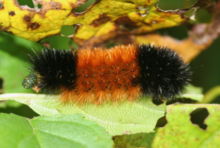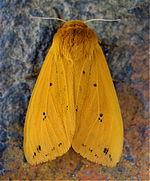- Pyrrharctia isabella
-
Pyrrharctia isabella 
Conservation status Not evaluated (IUCN 3.1)Scientific classification Kingdom: Animalia Phylum: Arthropoda Class: Insecta Order: Lepidoptera Family: Arctiidae Genus: Pyrrharctia Species: P. isabella Binomial name Pyrrharctia isabella
(JE Smith, 1797)The common moth Pyrrharctia isabella is known by different common names at its two main life stages. The adult is the Isabella Tiger Moth and the larva is called the Banded Woolly Bear. The larvae of many species of Arctiid moths are called "woolly bears" because of their long, thick, furlike setae (they are mostly spotted all black than they are as seen below). This species is black at both ends with a band of coppery red in the middle. The adult moth is dull yellow to orange with a robust, furry thorax and small head. Its wings have sparse black spotting and the proximal segments on its first pair of legs are bright reddish-orange. The insect can be found in many cold regions, including the Arctic. The banded Woolly Bear larva emerges from the egg in the fall and overwinters in its caterpillar form, when it literally freezes solid. First its heart stops beating, then its gut freezes, then its blood, followed by the rest of the body. It survives being frozen by producing a cryoprotectant in its tissues. Caterpillars normally become moths within months of hatching in most temperate climates, but in the Arctic the summer period for vegetative growth and hence feeding is so short that the Woolly Bear feeds for several summers before it finally pupates. Each spring it thaws out and emerges to feed and grow and after 14 years it finally pupates. Once it emerges from its pupa as a moth it has only days to find a mate before it dies.
It is the larvae of this species which are the subject of common folklore, which has it that the forthcoming severity of a winter can be predicted by the amount of black on the caterpillar; this is the most familiar Woolly Bear in North America. But in fact, larvae produced in the same clutch of eggs can vary from mostly red to mostly black, even when reared under the same conditions, and this variability invalidates any actual temperature-related trends that may otherwise be evident. In fact, the orange band will grow towards the ends of the body, with the black bands decreasing in size, as the larva matures.
The setae of the Woolly Bear caterpillar do not inject venom and are not urticant—they do not cause irritation, injury, inflammation, or swelling.[1] However, they will play dead if picked up or disturbed. Handling them is discouraged, however, as the bristles may cause dermatitis in people with sensitive skin.
This species is a generalist feeder—it feeds on many different species of plants, especially herbs and forbs.[2]
Contents
Self-medicating insect
Recent research[3] has shown that the Woolly Bear caterpillar may eat alkaloid-laden leaves to help fight off parasitic fly larva that can be laid inside their abdomens. This research showed what is called "the first clear demonstration of self-medication among insects". It is also known to eat pomegranate buds and is very picky about leaves.
Weather predictions
Folklore of the eastern United States and Canada holds that the relative amounts of brown and black on the skin of a Woolly Bear caterpillar (commonly abundant in the fall) are an indication of the severity of the coming winter. It is believed that if a Woolly Bear caterpillar's brown stripe is thick, the winter weather will be mild and if the brown stripes are narrow, the winter will be severe. In reality, hatchlings from the same clutch of eggs can display considerable variation in their color distribution, and the brown band tends to grow with age; if there is any truth to the aphorism, it is highly speculative.
Societal influence
The annual Woollybear Festival occurs each October in Vermilion, Ohio. The family event, started in 1973, features a Woolly Bear costume contest in which kids, even pets, are dressed up as various renditions of the woolly bear caterpillar.
There is also an annual Woolly Worm Festival that occurs in Banner Elk, NC. It began in 1977 and celebrated its 30th anniversary in 2007. The festival includes booths with crafts, food, and races. The winning Woolly Worm predicts the winter weather for the following winter.
There also is an annual Woolly Worm Festival that occurs in Beattyville, Kentucky. It started in 1987, and features many food booths, live music, a "Woolly Worm Race" in which people race the Woolly Bear caterpillar up vertical strings.
There is also an annual Woolly Worm Festival that occurs in Lewisburg, PA during early fall. This festival began in 1997, and includes crafts for kids, food, games, a pet parade, and a "Weather Prognostication Ceremony."
Oil City, Pennsylvania is producing a new character "Oil Valley Vick" who will predict the winter weather. It is hoped they can someday draw a crowd similar to Punxsutawney Phil.
References
- ^ Mullen, Gary Richard; Lance A. Durden (2002). Medical and Veterinary Entomology. Academic Press. ISBN 0125104510.
- ^ "Entomology Collection > Pyrrharctia isabella". E.H. Strickland Entomological Museum, University of Alberta. http://www.entomology.ualberta.ca/searching_species_details.php?s=215. Retrieved 2008-11-21.
- ^ ""Woolly Bear Caterpillars Self-Medicate -- A Bug First" - National Geographic". http://news.nationalgeographic.com/news/2009/03/090313-self-medicating-caterpillars.html?source=rss. Retrieved 2009-03-14.
Categories:- Butterflies and moths of North America
- Spilosomini
- Weather lore
Wikimedia Foundation. 2010.


